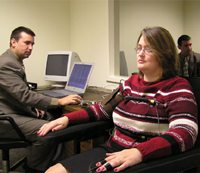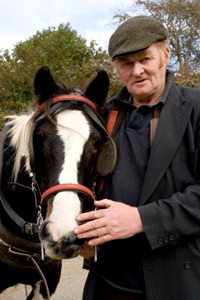How Case Derived: Past Life Regression
Researcher: Ian Stevenson, MD
From: Xenoglossy, by Ian Stevenson, MD
Article by Walter Semkiw, MD, from Born Again: Reincarnation Cases Involving Evidence of Past Lives with Xenoglossy Cases Researched by Ian Stevenson
Under Hypnosis or Past Life Regression, A Physician’s Wife Starts Speaking Swedish
 This case involves a physician who practiced medicine in Philadelphia, Pennsylvania, and his wife. As this physician wished to keep his identity private, Ian Stevenson documented the case using pseudonyms for the couple. Stevenson referred to the couple as KE, the physician, and TE, his wife. Since using initials makes it difficult to remember who is who, I will assign them first names for simplicity. KE will be called Ken and his wife, TE, will be referred to as Tania.
This case involves a physician who practiced medicine in Philadelphia, Pennsylvania, and his wife. As this physician wished to keep his identity private, Ian Stevenson documented the case using pseudonyms for the couple. Stevenson referred to the couple as KE, the physician, and TE, his wife. Since using initials makes it difficult to remember who is who, I will assign them first names for simplicity. KE will be called Ken and his wife, TE, will be referred to as Tania.
In addition to practicing mainstream medicine, Ken learned to do hypnosis in 1954 and he would practice on his wife. Ken found Tania to be a good hypnosis subject.
In sessions conducted from 1955 to 1956, when Tania was under hypnosis, a personality emerged who spoke Swedish, a language that neither Tania nor Ken knew. As such, this represents a case of xenoglossy, where an individual can speak a language that has not been learned through normal means.
Tania was born in Philadelphia and as such, English was her native language. Her parents, who were Jewish, were born in Odessa, Russia. No one in the family had ever been to Scandinavia and they knew no one who could speak Swedish.
Ian Stevenson Validates of Tania’s Xenoglossy: Lie Detector Tests Employed in this Reincarnation Case
 Ian Stevenson, as usual, studied this case in meticulous detail. He had three different Swedish people sign statements confirming that the language Tania was speaking was indeed Swedish. In the statements, it was noted that the accent was that of a natural Swedish speaker.
Ian Stevenson, as usual, studied this case in meticulous detail. He had three different Swedish people sign statements confirming that the language Tania was speaking was indeed Swedish. In the statements, it was noted that the accent was that of a natural Swedish speaker.
Stevenson also had transcripts and tape recordings analyzed by Swedish linguistic experts, who confirmed that Tania was speaking Swedish in a conversational manner. These experts also testified that an excellent Swedish accent was being spoken and that the language was an old form of Swedish, identified as Middle Swedish. Stevenson counted a vocabulary of over 100 Swedish words spoken by Tania.
In addition, Ian Stevenson had Ken and Tania take polygraph or lie detector tests to rule out fraud, which they passed. Stevenson concluded that this was a genuine case of responsive xenoglossy, in which Tania could carry on a conversation in Swedish.
Past Life Personality Jensen Jacoby Emerges and Describes Being Driven into Water & Struck on the Head
In Tania’s first hypnosis or past life regression session, she went back into a lifetime in which she, and a group of old people, were being forced into a body of water. Tania then felt she was being hit in the head and she experienced severe head pain. Due to her apparent suffering, Ken took Tania out of the hypnotic state. Still, Tania experienced head pain for the next two days and she repeatedly felt her head, looking for a lump.
In a subsequent session, Ken told Tania to go back ten years before the episode in which she was hit on the head. Tina then said, in English, in a deep masculine voice, “I am a man.” The personality with the deep voice stated that his name was Jenson Jacoby and that he was a farmer. (1)
In eight sessions that were held between 1955 and 1956, Jenson Jacoby appeared. In the first five sessions, he could understand and reply in English, but his English was halting and it was spoken with a heavy Swedish accent. Jenson could also speak and understand Norwegian. In sessions 6 through 8, Jenson only spoke Swedish. Tina had no memory of what happened in the hypnosis sessions when Jensen appeared.
 On the Swedish Coast, Past Life Personality Jenson Jacoby Raises Livestock, Eats Salmon & Hunts Bears
On the Swedish Coast, Past Life Personality Jenson Jacoby Raises Livestock, Eats Salmon & Hunts Bears
Jenson described that he lived in a tiny village called Morby Hagar, which was near a harbor town called Havero. Another nearby town was called Torohaven. Jensen related that he raised cows, horses, goats and chickens. He baked bread and made goat cheese. Jenson said that he would take his produce to be sold at Havero, the town with a sea harbor. At times, his family would eat salmon, which presumably came from the harbor town.
Jenson related that he was one of three sons. He had a wife whose name was Latvia, who made poppy-seed cakes and poppy-seed juice. The couple had no children. Jenson related that he built his own stone house, that he hunted for bears and that he liked to drink at a tavern. Jenson related that he worshiped Jesus Christ.
Past Life Personality Jenson Does Impersonations
 In one session, Jensen, speaking Swedish, did a comical impersonation of a drunken man at an inn trying to sing. Jenson also showed strong emotion when he was shown a picture of a horse, apparently as it reminded him of home.
In one session, Jensen, speaking Swedish, did a comical impersonation of a drunken man at an inn trying to sing. Jenson also showed strong emotion when he was shown a picture of a horse, apparently as it reminded him of home.
Xenoglossy: Jenson Knows Swedish Terms, Including a Skuta
Jenson knew of Swedish things from prior centuries. For example, when shown a model of a Swedish seventeenth century sailing ship, Jenson correctly called it a “skuta” or “skute.” He also correctly named a Swedish container used to measure grain. When shown a picture of a wolf, he correctly named it in Swedish.
In contrast, when shown a modern tool, such as a pair of pliers, Jenson could not name it.
Jenson’s Past Life Hatred for War & Russians
Jenson described a hatred for warfare and a fear of Russians. When asked how his life ended, Jenson related that he was engaged in some type of fight with enemies, was forced into a body of water and received a blow to the head, which apparently killed him.
This statement corresponds to the memory that Tania experienced when she was first put under hypnosis, as well as her subsequent headache, which made her search for a lump on her head.
Reincarnation versus Possession
 Ian Stevenson, firmly believed in the legitimacy of the case of Jenson Jacoby | TE. He notes that the physician who conducted the hypnosis sessions on his wife, KE, who we have named Ken, never sought publicity for the case. Based on the polygraph testing and his familiarity with the couple involved, Stevenson rejected that any fraud was involved.
Ian Stevenson, firmly believed in the legitimacy of the case of Jenson Jacoby | TE. He notes that the physician who conducted the hypnosis sessions on his wife, KE, who we have named Ken, never sought publicity for the case. Based on the polygraph testing and his familiarity with the couple involved, Stevenson rejected that any fraud was involved.
Stevenson concluded that Jenson Jacoby had once lived on the west coast of Sweden, near Norway, in the seventeenth century. Gothenburg is the largest city in this area. Place your cursor on the map to enlarge it and arrow keys to scroll up and down.
As Tania, or TE, had no memory of what occurred when Jensen appeared, Stevenson did raise the question of whether this represented a case of reincarnation or of possession by a discarnate spirit. Either way, Stevenson commented that the case represented strong evidence for the survival of personality after death.
Stevenson did feel that reincarnation may be the more plausible explanation. In defense of this position, he posed the following question:
If Jenson was a discarnate spirit, why would the Christian, Swedish spirit from the seventeenth century, Jenson Jacoby, show up in Philadelphia in 1955, speaking through a Jewish woman of Russian descent?
Principles of Reincarnation & Understanding Past Lives
Xenoglossy: Jenson only spoke Swedish, a language that Tania did not learn or understand.
Change of Religion and Nationality: Jenson was a Swedish Christian who feared Russians, while Tania was Jewish and of Russian heritage.
Soul Retains Personality Intact: Jenson came through Tania as if he were stuck in time, unaware that he was dead or that Tania had a separate existence. As such, it appears that Jenson’s personality had been retained intact within the soul.
Other xenoglossy cases which dramatically demonstrate this phenomenon include the Sharada | Uttara Huddar case and the Gretchen | Dolores Jay case.
Note to Readers: Ian Stevenson. MD was a Professor of Psychiatry at the University of Virginia who wrote in a very academic style, as his target audience was fellow scientists. On the IISIS web site, his past life identity cases are presented as children’s past life-reincarnation stories to make his academic work easier to understand. For those interested in appreciating the scientific rigor of his research, such as his use of multiple witnesses to establish corroborated testimony, please refer to the original reports written by Dr. Ian Stevenson.
Footnotes
1. Stevenson, Ian: Xenoglossy: A Review and a Report of a Case, 1976, page 26







